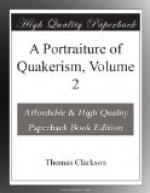Actuated by such sentiments as these, the Quakers have discarded all parade at their funerals. When they die, they are buried in a manner singularly plain. The corpse is deposited in a plain coffin. When carried to the meeting-house or grave-yard, it is attended by relations and friends. These have nothing different at this time in their external garments from their ordinary dress. Neither man nor horse is apparelled for the purpose. All pomp and parade, however rich the deceased may have been, are banished from their funeral processions. The corpse, at length, arrives at the meeting-house[2]. It is suffered to remain there in the sight of the spectators. The congregation then sit in silence, as at a meeting for worship. If any one feels himself induced to speak, he delivers himself accordingly; if not, no other rite is used at this time. In process of time the coffin is taken out of the meeting-house, and carried to the grave. Many of the acquaintances of the deceased, both Quakers and others, follow it. It is at length placed by the side of the grave. A solemn, silent pause, immediately takes place. It is then interred. Another shorter pause then generally follows. These pauses are made, that the “spectators may be more deeply touched with a sense of their approaching exit, and their future state.” If a minister or other person, during these pauses, have any observation or exhortation to make, which is frequently the case, he makes it. If no person should feel himself impressed to speak, the assembled persons depart. The act of seeing the body deposited in the grave, is the last public act of respect which the Quakers show to their deceased relations. This is the whole process of a Quaker-funeral.




